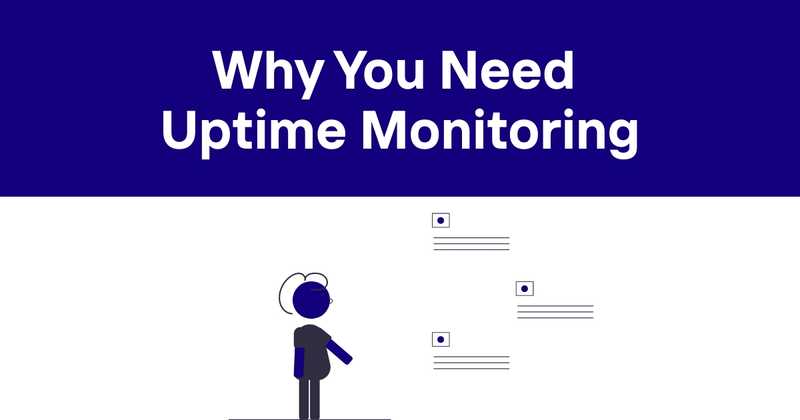5 Critical Reasons Your Company Needs Uptime Monitoring
Literally, your company website and digital services are the faces of your business in today's digital-first world. They might be the first touchpoint with a customer and at the very same time, the lifeline to some already acquired. What if this all-important digital asset goes down? Anything from lost revenue to a dented reputation-the consequences are many. That's where uptime monitoring steps in; it plays the role of a watchful guardian of your online presence.
It's a lot more than a mere technical requirement; rather, it's a strategic tool in terms of uptime monitoring having an impact on the bottom line and customer satisfaction. Let's go further and see what five convincing reasons make uptime monitoring really crucial for your company.
Table of Contents
- Safeguarding Revenue and Reputation
- Enhancing User Experience and Customer Satisfaction
- Improving Incident Response and Problem Resolution
- Optimizing Website Performance and Speed
- Ensuring Security and Compliance
- Implementing Effective Uptime Monitoring
- Conclusion
Safeguarding Revenue and Reputation
Just consider the financial blow caused by website downtime alone: various studies peg the average cost of downtime, depending on the size of the company and the industry, between $140,000 and $540,000 per hour. A few minutes of web downtime during peak shopping hours can cost an e-commerce site dearly in revenue losses.
However, the hurt goes beyond direct financial losses. Prolonged or frequent downtime can result in erosion of trust among your clients and damage to your brand reputation. And in the day and age when alternatives are mere clicks away, customers will most likely not give you a second try if they find your site consistently down.
Uptime monitoring helps mitigate these risks by:
- Providing real-time alerts when your website or services become unavailable
- Enabling quick response to minimize downtime duration
- Offering historical data to identify patterns and prevent future incidents
Consider this: an e-commerce enterprise experiences one hour of downtime during a major sale event. With no uptime monitoring, they may easily not even realize there was an issue in the first place until customers complain on social media. Then they lose thousands of dollars in sales, probably much more in brand reputation. Given the uptime monitoring, they could have received immediate notification to reduce actual time to mere minutes and save both revenues and face.
Enhancing User Experience and Customer Satisfaction
In the digital era, it's all about user experience. They want the sites and apps to be up 24/7, load in a snap, and work perfectly. Anything less than that, and they get frustrated, followed by churning.
Uptime monitoring contributes to a positive user experience by:
-
Ensuring Availability: By continuously checking your website's status, uptime monitoring helps maintain high availability, meeting user expectations for round-the-clock access.
-
Monitoring Page Load Times: Many uptime monitoring tools also track page load speeds, helping you identify and address performance issues that could frustrate users.
-
Checking Functionality: Advanced monitoring can verify that key features like login systems, shopping carts, and contact forms are working correctly.
-
Providing Insights for Improvement: By analyzing uptime data, you can identify trends and make informed decisions to enhance overall site performance and reliability.
Real-life scenario: For instance, some SaaS companies noticed slow and steady but sure growth in support tickets regarding the issue of slow loading. The application of uptime monitoring with performance tracking had them finding out that their database queries were growing inefficiently along with their user base. That kind of insight allowed them to optimize their database and further down the line decrease the load times, supporting a 30% reduction in related tickets.
Improving Incident Response and Problem Resolution
And when things do go wrong, it is often speed and efficiency that make all the difference. Uptime monitoring equips one with the tools and data necessary for identifying, diagnosing, and resolving issues as rapidly as possible.
Key benefits include:
- Instant Notifications: Receive alerts via email, SMS, or push notifications as soon as an issue is detected.
- Detailed Diagnostics: Many monitoring tools provide information about the nature of the problem, such as whether it's a server issue, network problem, or application error.
- Historical Data: Access to past incident data can help identify recurring issues and inform long-term solutions.
- Performance Benchmarks: Establish baselines for normal operation, making it easier to spot anomalies.
For example, to explain how Response is prompt in its response: A media streaming service experiences scattered outages at the worst time to view. Its uptime monitoring system detected that issue and also provided data showing these troubles coincided with spikes in traffic. That prepared them for faster deployment of load balancing solutions, scaling up, hence reducing downtime and generally improving service delivery.
Optimizing Website Performance and Speed
Website speed and performance are critical factors in user satisfaction and search engine rankings. Uptime monitoring tools often include features that go beyond simple availability checks, offering insights into various performance metrics.
These tools can help you:
- Track Page Load Times: Monitor how quickly your pages load from different geographic locations.
- Identify Slow-Loading Elements: Pinpoint specific page elements or scripts that may be causing performance issues.
- Monitor Server Response Times: Keep an eye on how quickly your servers are responding to requests.
- Assess Third-Party Service Impact: Evaluate how external services and APIs affect your site's performance.
Here's a table summarizing key performance metrics and their impact:
| Metric | Description | Impact |
|---|---|---|
| Time to First Byte (TTFB) | Time it takes for a browser to receive the first byte of data from the server | Affects overall page load time and user perception of site speed |
| Page Load Time | Total time it takes for a page to fully load | Directly impacts user experience and bounce rates |
| Server Response Time | Time it takes for the server to respond to a request | Influences overall site speed and can indicate server health issues |
| DNS Lookup Time | Time it takes to translate a domain name to an IP address | Can affect initial connection speed |
| SSL Negotiation Time | Time it takes to establish a secure connection | Important for e-commerce and sites handling sensitive data |
Ensuring Security and Compliance
It's more essential than ever to do some uptime monitoring and leave security and compliance to be sorted out on the margins of resources.
Uptime monitoring contributes to security and compliance by:
-
Detecting Unauthorized Changes: Some monitoring tools can alert you to unexpected changes in your website's content or structure, which could indicate a security breach.
-
SSL Certificate Monitoring: Ensure your SSL certificates are always up-to-date and functioning correctly, maintaining secure connections for your users.
-
Compliance Reporting: Generate uptime and performance reports that may be required for certain industry regulations or service level agreements (SLAs).
-
Early Warning System: Rapid detection of downtime or performance issues can help identify potential security incidents early.
For instance, one of the financial service firms noticed a weird spike in server response times through its uptime monitoring system. They found, after investigations, that DDoS was in process. With early notice, they could carry out the mitigation measures with negligible attacks and staying within the regulatory laws of the financial industries.
Implementing Effective Uptime Monitoring
Having seen some critical reasons for the implementation of uptime monitoring, let's proceed with how to set up an effective monitoring system.
-
Choose the Right Tool: Select a monitoring solution that fits your specific needs. Consider factors like the types of checks offered, reporting capabilities, and integration with your existing tools.
-
Set Up Multiple Check Types: Don't just monitor for uptime. Implement checks for performance, functionality, and security.
-
Configure Appropriate Alert Thresholds: Set alert thresholds that balance between being informed and being overwhelmed. For example, you might want immediate alerts for complete outages, but only be notified of slow performance if it persists for several minutes.
-
Monitor from Multiple Locations: If you have a global audience, ensure you're monitoring your site's performance from various geographic locations.
-
Regular Review and Adjustment: Periodically review your monitoring setup and adjust as needed. Your website and business needs may change over time.
-
Implement a Response Plan: Develop a clear plan of action for different types of alerts. Who should be notified? What are the first steps to take?
-
Use Synthetic Monitoring: In addition to real-user monitoring, implement synthetic monitoring to simulate user interactions and catch issues before they affect real users.
Here's a sample uptime monitoring implementation plan:
- Week 1: Research and select an uptime monitoring tool
- Week 2: Set up basic uptime checks and alerts
- Week 3: Implement performance monitoring and set appropriate thresholds
- Week 4: Set up functionality checks for critical user journeys
- Week 5: Implement security-related checks (SSL, content changes)
- Week 6: Develop and document incident response procedures
- Week 7: Train team members on the new monitoring system and response procedures
- Week 8: Review initial data, adjust thresholds and checks as needed
One must bear in mind that uptime monitoring is not about notifications when something goes down; rather, it is to let you in on a few tips to continuously make your website performance even better, ever more reliable, and secure.
Conclusion
In today's digital landscape, uptime monitoring is no longer a nice-to-have, but an absolute must. Safeguarding revenue and reputation, enhancing user experience, improving incident response, performance optimization, and security and compliance-all point toward the very vital role that uptime monitoring plays in making an online presence successful.
Yet, with the best uptime monitoring setup in place, you're not just securing your website; you're protecting the digital lifeblood of your business. You ensure customers always have a good experience with you, your group is quick and able to handle any problem, and that you have all the information you need to make intelligent decisions about your digital infrastructure.
Remember, every second counts in e-commerce. Rather than waiting for your customers to report problems, get ahead of them with uptime monitoring. Your business may depend on it.



